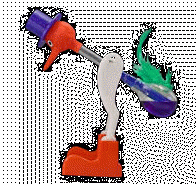|
Power
[////////// under construction
//////////]
Objectives
• Know that power can be calculated as the rate that
work is done.
• Be able to select and use the equation
power = work done ÷ time
• Be able to use solve problems which combine ideas of
mass, weight, work done and power.
Task 1
Remind the person next to you:
• What is meant by power?
• What is meant by a power of 5 Watts?
• What are the units of Work done?
Task 2
We know that power is the
rate that energy is used - or to put it another way, the
rate that work is done. We
need to be able to calculate work done by a device, and then use this
information to be able to calculate the power.
You met the formula for power during the "Core
Science" course:
|
P =
E ÷ t
|
P =
Power, measured in Watts (W)
E = Energy
transferred (or work done), measured
in Joules (J)
t = time taken,
measured in seconds (s) |
Make a note of this formula in your exercise book, and
show it as an equation triangle. You will also need the formula
for work done from last lesson, and the formula which
connects mass and weight.
|
Now, lets try calculating the power of
these athletes. In each case you will need to
calculate the work done first, and then use that
information to calculate the power.
1. A weight-lifter takes
0.7 seconds to lift 60kg (600N) through 0.5m.
2. A fitness fanatic lifts
30kg (300N) through 0.6m. He repeats the exercise 12
times, which takes him 30 seconds.
3. Another fitness fanatic
lifts 40kg through 0.8m. He repeats the exercise 20
times, which takes him 1.5 minutes.
4. A runner travels 800m
against a frictional force of 60N, and takes 2 minutes.
5. A student has a mass of
50Kg and jumps 0.7m into the air. The student repeats
this 10 times, which takes them 15 seconds. |
Task 3
These problems combine all of the ideas encountered above, but
require you to think a little more. Complete the questions in your
exercise book, showing full working for all problems.
Use g = 10 N kg-1 for all problems.
Task 4
A
|

